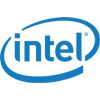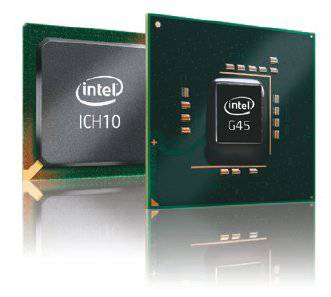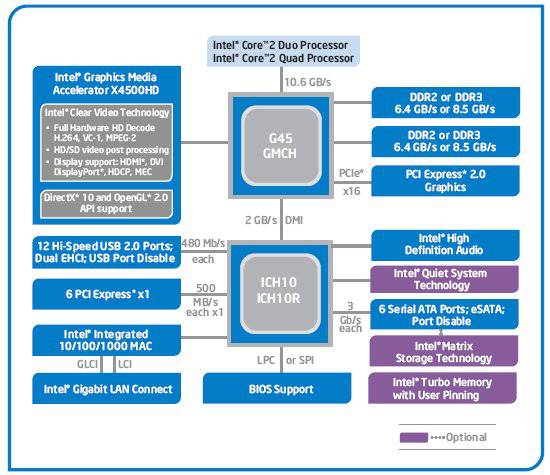- Qualcomm Launches Snapdragon 4 Gen 2 Mobile Platform
- AMD Launches Ryzen PRO 7000 Series Mobile & Desktop Platform
- Intel Launches Sleek Single-Slot Arc Pro A60 Workstation Graphics Card
- NVIDIA Announces Latest Ada Lovelace Additions: GeForce RTX 4060 Ti & RTX 4060
- Maxon Redshift With AMD Radeon GPU Rendering Support Now Available
Intel 4-Series Chipsets: G43, G45, P45

Intel’s next-generation chipset offerings in the mid-range and enterprise-level markets have arrived in the form of three mid-range offerings in Intel’s 4-Series of chipsets, including two with integrated graphics. In this article, we’ll lay out the differences, and help you understand your new options.
Page 2 – G45 Express, G43 Express, Final Thoughts
We’re taking a look at three new motherboard chipsets from Intel, as part of their “4-Series” lineup of chipset products. The P45 Express chipset provides affordable performance in the mid-range category, and is a good choice for the majority of enthusiast systems.
However, perhaps more important in the consumer market are the integrated-graphics products, since these are the chipsets that find their way into the majority of consumer PCs, which shave dollars off the total hardware cost by avoiding discrete graphics altogether. Intel is bringing two new integrated-graphics contenders to the table, the G45 Express and G43 Express integrated-graphics chipsets.

The big news with the G45 and G43 graphics processors is their use of an integrated Intel Graphics Media Accelerator X4500 core, which supports both Microsoft’s DirectX 10 and the forthcoming OpenGL 2.0 standard, though OpenGL 2.0 support will be added later by a software update. Shader Model 4.0 support is also present. The G43 and G45 Express chipsets otherwise duplicate the full functionality of the P45 Express chipset, with the only difference being the fact that the G43 and G45 integrate different levels of video processing hardware.
G45 Express
Intel’s G45 Express chipset is the higher-end offering of the two new integrated graphics chipsets being released, its feature set targeted toward media center PC and home theater PC applications. The GMA X4500 graphics core receives an “HD” designation here, because most of the difference in functionality between the G43 and G45 chipsets relates to hardware acceleration of video playback and post-processing functions.

The Intel GMA X4500HD video processor incorporates a trio of features that will be of importance to home theater and media center PC builders, one of them an absolute necessity if you’re planning on playing back any Blu-Ray discs anytime soon: HDCP compliance. High-Definition Content Protection, known around here as simply ‘HDCP’, is a content protection scheme used by modern hi-def formats like the late HD-DVD and the victorious Blu-Ray format. HDCP requires digital handshaking at every stage in the signal chain, starting at the player itself. That means that your PC’s graphics adapter will need to be HDCP-compliant in order to play back hi-def media at its full resolution, instead of a scaled-down standard-definition resolution. HDCP compliance is pretty much a given at this point on any hardware that features an HDMI connector, and the GMA X4500HD also supports the integration of an HDMI video output.
The GMA X4500HD video processor also brings Intel’s integrated-graphics offerings up to speed with the competition when it comes to hardware acceleration of HD video playback. AMD has had their AVIVO HD with UVD for some time now, and NVIDIA has had PureVideo HD. The GMA X4500HD offers similar hardware HD processing, accelerating H.264 playback at 1080p resolution. In addition, Intel has brought their Clear Video Technology to bear on the GMA X4500HD to provide post-processing functionality that improves color saturation and accuracy, and eliminates artifacts in playback. This places the X4500HD on more even footing with AMD’s 780G and 790GX IGP chipsets and Intel’s new GeForce 8300 “Motherboard GPU” when it comes to suitability for home theater PC use.
G43 Express
While Intel’s G45 Express chipset represents a higher-end integrated-graphics product, with its HD video processing and enhancement features, the G43 Express is an enterprise-class part (a kind way of saying ‘low-end’) that omits the HD video processing entirely. It’s still got a DX10-capable Intel GMA X4500 integrated graphics core, however, which is important for another reason – Intel’s low-end integrated-graphics chipsets have typically represented the low-end baseline for the entire integrated-graphics product category.
The GMA X4500 lacks the “HD” designation of the core that’s packed into the Intel G45 Express northbridge, but it still offers Intel Clear Video technology, for post-processing of video playback to reduce jitter, smooth edges, and improve brightness and color saturation. It also supports multiple digital outputs, though you won’t see an HDMI connector hanging off a G43 Express motherboard at any point in the near future.
Final Thoughts
The release of Intel’s new 4-Series chipsets is an important step forward for the company, and for the state of motherboard chipsets in general. They’ve managed to close the gap somewhat with AMD in the power consumption realm, with measurable power savings (as Rob discovered in the review of the ASUS P5Q Deluxe). The P45 is, by and large, an evolutionary part – there aren’t major earth-shattering changes, except for the shrink in manufacturing process. PCI Express 2.0 support will enable similar performance to current PCI Express embodiments, but with fewer lanes total, so the fact that the P45 only has 16 PCI-E 2.0 lanes to divide up isn’t a major tragedy with current graphics cards.
Much more notable with the move to the 4-Series is the introduction of the GMA X4500 graphics core, even with the enterprise-class X43. The very fact that Intel has chosen to anchor their 4-Series product lineup with a DirectX 10 part does two things – it pushes AMD’s value-line 690G chipset into virtual irrelevance as a DX9 part with Shader Model support that’s limited to Version 2.0, and it states definitively that the bottom end of the integrated-graphics totem pole will be a DirectX 10 part, effectively sounding the death knell for DirectX 9 parts.
Intel’s 4-Series chipset release is more exciting than it has any right to be, given the mere fact that it’s a chipset release, and not something sexier like a range of CPUs or GPUs. However, the excitement is mainly clustered around the G45 graphics processor, which combines all the functionality of P45 with the Intel GMA X4500HD graphics processor, for a part that’ll be in high demand among builders of media center and home theater PCs, and go toe-to-toe with high-end integrated-graphics offerings from manufacturers whose names are more synonymous with graphics performance. Time and further testing will tell whether the G45 has what it takes to grab a significant chunk of the media center PC market.
Discuss in our forums!
If you have a comment you wish to make on this article, feel free to head on into our forums! There is no need to register in order to reply to such threads.
Support our efforts! With ad revenue at an all-time low for written websites, we're relying more than ever on reader support to help us continue putting so much effort into this type of content. You can support us by becoming a Patron, or by using our Amazon shopping affiliate links listed through our articles. Thanks for your support!




